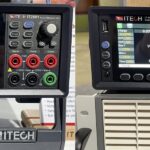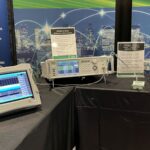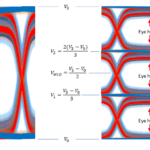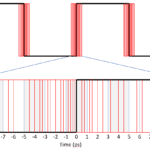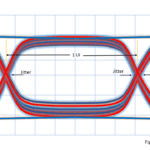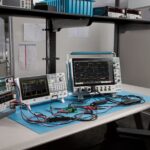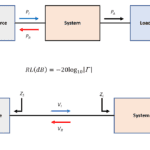Test equipment is everywhere. Every trade show has it regardless of the focus. Power is no exception. At APEC 2024, EE World visited several booths displaying test equipment: meters, oscilloscopes, source-measure units (SMUs), bench power supplies, and electronic loads. The photos and videos below highlight what we saw, presented in alphabetical order by company. In […]
Tektronix
AOC 2023: Exhibits show the latest in military wireless
Washington — The Association of Old Crows (AOC) held its 60th annual convention in Washington during the week of December 11, 2023. EE World was there on December 12. Here is some of what we saw in the exhibit hall. AOC is a defense-oriented conference that focuses on military wireless communications. In addition to product […]
Product tryout: Tektronix 4 Series B oscilloscope
EE World gets its hands dirty on the latest Tektronix oscilloscope. So many features, so little time. When Tektronix gave the press a preview of the 4 Series B 12-bit mixed-signal oscilloscope and TekScope software, I asked to try the software. Days later, the real thing arrived in a transit case. Fortunately and unfortunately, today’s […]
Free drivers connect Tektronix instruments to Python
Tektronix announced an open-source Python instrument driver package for the company’s test instruments. Available at no cost, the package provides you with a native Python user experience for instrument automation. With integration into daily workflows and utilizing it with a preferred Integrated Development Environment (IDE), engineers use features such as auto-complete, precise type hinting, comprehensive […]
What are the important specifications of USB oscilloscopes: Part 2?
USB oscilloscopes can be highly useful design, development, and testing tools. Like many tools, they need to be optimized for specific use cases. This second FAQ looks at specifications for triggering, input ranges and probes, zooming, and control software. Part 1 considered specifications for the number and types of channels, bandwidth, sample rate, refresh rate, […]
What is PCIe gen 6 and how do I test it? Part 2
PAM4 modulation boosts throughput but adds test challenges. Part 1 of this two-part series described the evolution of the PCI Express (PCIe) standard, including the move from non-return-to-zero (NRZ) signaling in PCIe 5 to four-level pulse-amplitude modulation (PAM4) signaling in PCIe 6. What unique test challenges does PCIe 6 present? As mentioned in Part 1, […]
What is jitter and what can I do about it (part 2 of 2)?
Operations on acquired jitter data help quantify jitter values. Part 1 of this article described the oscilloscope eye diagram and unit interval (UI) and focused on a single ideal rising edge with 28 additional edges representing some degree of jitter (Figure 1). We determined the peak-to-peak jitter to be 15 ps, based on the edges […]
What is jitter and what can I do about it (part 1 of 2)?
Measuring and quantifying jitter are the first steps toward controlling it. Jitter is a measure of the timing performance of a digital data stream such as Ethernet, USB, PCIe, or HDMI. It defines when data transitions occur in relation to an ideal waveform. Excess jitter can lead to signal-integrity problems that result in high bit-error […]
Automate double-pulse testing in WBG devices
By automating double-pulse testing of wide bandgap devices such as SiC and GaN power devices, you can cut setup and analysis time. The need to reduce carbon emissions drives investments in electrical technologies, particularly in data centers and electric vehicles. In its most recent Elective Vehicle Outlook report, Bloomberg estimates a 27% increase in global […]
What are insertion loss and return loss and how can I measure them?
These basic RF measurements often uncover system problems in wired and wireless communications. If you observe a signal traveling from a source to a load through a passive system of some sort, you will notice that the signal attenuates by the time it reaches the load, and you will also notice that some of the […]
